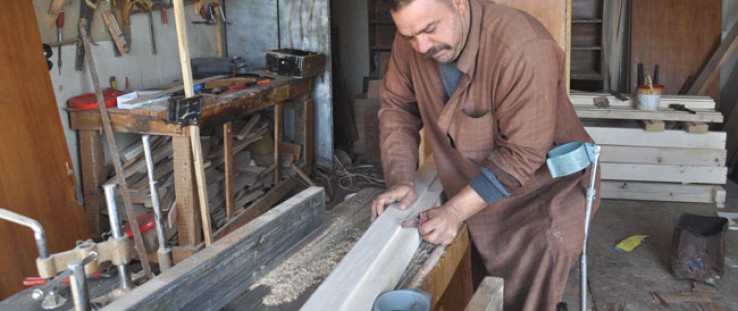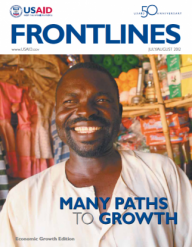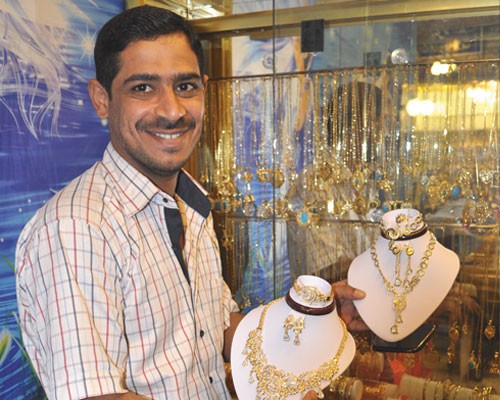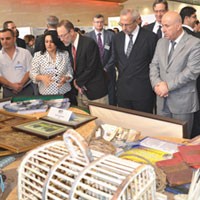 Faris Malik in his expanded Tikrit workshop.
credit: Louis Berger Group
Faris Malik in his expanded Tikrit workshop.
credit: Louis Berger Group
 Faris Malik in his expanded Tikrit workshop.
credit: Louis Berger Group
Faris Malik in his expanded Tikrit workshop.
credit: Louis Berger Group
Saad Abdul Ridah Hassan grew up poor in Diwaniyah, an impoverished town of 450,000 almost 100 miles south of Baghdad. At age 7, he began selling newspapers to motorists at traffic lights. It took 17 years for him to scrape together enough money to rent a tiny space for a stationery shop.
But Hassan’s life began to change in 2005 when a USAID-supported microfinance institution loaned the ambitious entrepreneur $3,000 to expand his shop.
He paid the money back and received four additional microloans to open two more stores, enlarge his three shops and lease another to sell men’s clothing, housewares and costume jewelry. At 32, Hassan has wisely invested five microloans totaling $38,000. His businesses currently employ five people, earn $15,000 a month in profit, and generate double that in monthly revenues.
Iraq’s future depends on economic growth led by the private sector. And USAID’s support for reliable institutions that provide predictable sources of credit is enabling thousands of businesses like Hassan’s to expand, fueling Iraq’s growing private-sector economy.
These efforts have created over 212,000 new jobs in the service, trade, manufacturing, construction and agricultural sectors. Indirectly, microfinancing has generated over 300,000 more jobs by saving existing businesses temporarily short of cash, allowing entrepreneurs to take advantage of opportunities they otherwise could not have, and inducing wholesale suppliers to add workers. Strategic microfinance loans also help subsistence farmers to get by between planting and harvest.
Building an Iraqi Microfinance Industry
The absence of a significant modernized banking system or microfinance industry in 2005 strained Iraqi enterprises and entrepreneurs. The rising tide of civil conflict was an additional burden on the economy.
During those war-torn years, USAID helped establish the country’s first indigenous microfinance institutions and began to support the transition of the country’s private commercial banks towards modern standards. Since then, nearly 400,000 microloans—ranging from $500 to $5,000—have been disbursed throughout Iraq with a combined value of more than $1 billion and a 98-percent payback rate.
There are currently nearly 89,000 active microloan recipients—nearly a quarter of them women—who have borrowed a combined $134 million for anything from starting a kindergarten, mini-market or auto garage to buying a taxi, expanding a home-based business or buying industrial equipment.
Since 2004, in fact, USAID partner microfinance institutions have disbursed loans to more than 64,000 women in Iraq, sustaining 52,000 women-held jobs.
Iraq’s microfinance industry has matured with the assistance of USAID/Iraq’s Tijara Provincial Economic Growth Program. Three years ago, microfinance institutions began disbursing solidarity group loans to small market and neighborhood vendors who guarantee each other’s repayment. Such loans have enabled more than 60,000 borrowers, who were previously unable to qualify for a loan, to invest around $60 million in microloans to start or expand their businesses. Many, like Hassan, are disadvantaged men and women who, before gaining access to credit, were forced to survive at the Iraqi national poverty line of $2.20 a day.
“Thanks to increased staff capacity and strong operating systems, the Iraqi microfinance industry, as of April 2012, has achieved a remarkable 13 percent growth in the number of clients and 22 percent growth in outstanding portfolio compared to the previous year,” said Abbas Saedy, general manager of the Al-Thiqa Organization for Microfinance in Kirkuk.
Adjusting for Culture
The Islamic prohibition against charging interest required financial institutions to adapt. Because tribal sheiks were consulted on the design of sharia-compliant microfinance loans, religious leaders in provinces such as Anbar issued fatwas asserting that USAID-supported microfinance institutions were religiously acceptable. About 14 percent of all microfinance loans outstanding in Iraq are based on Islamic murabaha financing, which involves charging a service fee rather than interest.
Outside the Islamic world, a customer borrows money from a lender at a fixed rate of interest for a specific amount of time. The money, plus interest, is paid back to the lender when the loan is due. In murabaha financing, the lender purchases the goods directly and delivers them to the customer, who, at an agreed time, repays the lender for the cost of the goods plus a fee for the lender buying the merchandise.
The Al-Aman Center in Kirkuk, one of 12 microfinance institutions supported by USAID, began providing Islamic financing in 2009 to young couples who wanted to start their own families but lacked the money to furnish homes of their own.
A $1,800 microfinance loan made it possible for Ziyad Fadhel Nayif, 35, and his 30-year-old wife, Bahya Awad Hasn, to move into their own apartment after three years of engagement. Instead of loaning money with interest, Al-Aman purchased the newlyweds’ furnishings, decorations and appliances. Al-Aman then charged the couple a fee based on the amount of money it spent to buy the household items. This different structure allowed the couple to get the things they needed to live independently. Says Nayif: “Having my own home means Bahya and I now can think about having a real family of our own.”
Because of their smaller amounts, microloans can only finance micro-enterprises; small- and medium-sized enterprises need larger amounts of credit, usually between $5,000 and $250,000. The Tijara project also works with 13 private commercial banks that have dedicated small- and medium-sized enterprise lending units.
These lending units have disbursed nearly 8,500 loans with a combined value of $150 million. For example, with a $26,000 loan, the underserved neighborhood of Al-Obaidy in Baghdad was able to set up a profitable medical clinic staffed with doctors, pharmacists and dentists. And a $13,000 loan allowed the Al-Sabaya Sweets shop in Mosul to rebuild three bakeries after they were destroyed by terrorists.
Nearly 700 of these larger loans went to Iraqi women, and as a result, around 1,500 women now have access to better employment opportunities.
Credit for Those Who Need It Most
The Tijara project is now working with three microfinance institutions and five commercial banks to implement the Iraqi Vulnerable Groups Support Initiative (IVGS), which aims to provide low-cost microfinance and small- and medium-enterprise loans to internally displaced persons, ethnic and religious minorities, female-headed households, youth and other vulnerable groups.
Faris Malik, a 35-year-old carpenter who escaped to Salah ad Din province when his Baghdad neighborhood was engulfed by sectarian violence, used a $10,000 loan to expand his Tikrit workshop, purchase better tools and hire three young employees. Before he got his IVGS loan, Malik had already received and repaid five microfinance loans, several of which enabled him to win a major contract renovating classrooms at the University of Tikrit. Says Malik: “Because of USAID loans, my business is well-equipped and always busy.”
IVGS gives vulnerable Iraqis like Malik the opportunity to rebuild their lives by establishing sustainable livelihoods, providing economic value to the communities in which they have settled, and offering a long-term path toward a better life.
“Because we have helped to establish a sustainable network of microfinance institutions, we are well-positioned to help vulnerable groups,” says Alex Dickie, USAID’s mission director in Iraq. “This new program specifically targeting vulnerable groups simply wouldn’t be possible without years of work to build a broader, sustainable microfinance industry in Iraq.”
Iraq continues its transition from a state-dominated economy under dictatorship to a more market-oriented one under a democracy. Access to credit for micro-, small, and medium enterprises and strong financial institutions is critical to Iraq. It is the private sector that helps offset fluctuating oil prices and infuses the country with an entrepreneurial spirit that could generate the majority of the country’s jobs in the future.
“A successful private-enterprise economy begins with small businesses like Mercy Clinic in Baghdad, Mosul’s Al-Sabaya Sweets and Saad Abdul Ridah Hassan’s gift shops in Diwaniyah,” says Ali Al-Hussainy, the project manager for USAID-Tijara. “Iraq’s future prosperity will be determined by these small companies growing into larger ones.”
David DeVoss is communications director for USAID-Tijara.











Comment
Make a general inquiry or suggest an improvement.